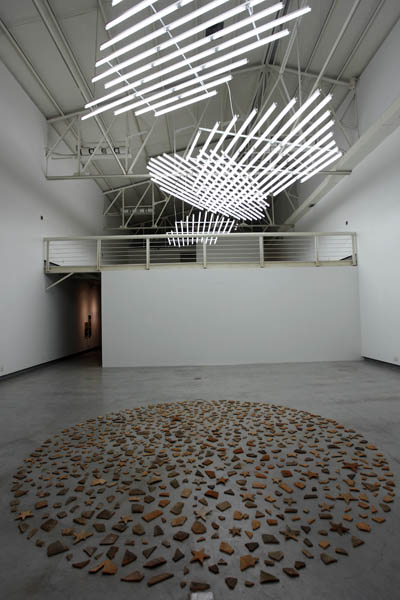LI JINGHU: ONE DAY IN DONGGUAN
| February 1, 2010 | Post In LEAP 1

Like the show’s title states, what Li Jinghu confronts is a kind of quotidian experience, and from his found objects we see that while he uses items ordinarily buried in daily life, he tries to rescue them from mediocrity, allowing them a surprising radiance. Li particularly emphasizes the transformation of our experience of common items. In one piece, Counting Stars, roof tiles from his old house are cut into star shapes and spread on the floor. In Rainbow, plastic household items are sorted by color and arranged in a spectrum along the stairs. These transformations sound a lyric note, allowing us to view these objects in a completely different way, like phrases in a poem.
Of course, any everyday experience has its own specific backdrop, and Li Jinghu’s show, as evinced by its title, is fixed in a particular local experience. Dongguan, at least according to the mainstream media, is representative of what China’s economic reforms have wrought. But for Li, Dongguan is the place he grew up and still lives; his primary sensitivity is toward the changes and rapid modernization (the official line in Dongguan is that one hundred years of development have been accomplished in twenty) that have affected traditional modes of life, the lives of Li and the locals, as well as those of newly arrived laborers.
The factory has replaced the ancestral home, farmers have turned into workers and villages into industrial parks: this is an experience Chinese people know all too well. But when the abstract, endlessly recited concepts of modernization, urbanization and globalization are actually implemented, complications are bound to ensue. For Li Jinghu, change in Dongguan is very difficult to reduce to one simple meaning—this is not a story of Reform and Opening’s mighty victory, nor is it one of modern dystopia. His story is composed detail by detail, angle by angle, and cannot be addressed by the abstract figures of sociology, economics or any other discipline, or be processed into empty laments of false humanism.
“A total absence of illusion about the age and at the same an unlimited commitment to it–this is its hallmark.” (Walter Benjamin) Li Jinghu’s story manifests just such an attitude. With the course of modernization as its backdrop, Li’s lyricism cannot help but exhibit some nostalgia, but this nostalgia is not aloof or exalted. In Li’s world, nostalgia does not come from past tradition or an idealized future. Rather, it is a present reality. He places himself with those laborer outsiders in what we might call a “grassroots” reality, attempting to discover experience unfiltered by ideology and uncover a kind of redeeming aesthetic power. Put simply, Li Jinghu is creating a means of looking afresh at the present.
The pieces White Clouds and Factory transform the factory experience. In White Clouds, Li arranges the fluorescent tubes of factory ceilings into cloud forms; in Factory he displaces plant labor with bodybuilding. In the exhibition space, workers in athletic clothing on exercise equipment sweat away as the machines clank, just as they might experience in everyday work. However, the means of experience has been transformed, and their labor is liberated from the instrumental, becoming activity for its own benefit. Any kind of existence can be re-experienced and people can cast off the shackles of their own lives; perhaps this is what Li Jinghu hopes we take away from his show. Bao Dong

